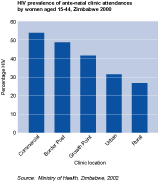It has been estimated that HIV/AIDS is reducing the growth in gross national product (the value of what a country produces in a year) in countries in Southern Africa by between 0.5% and 1.5% per year.
In other words, national income is growing more slowly than it would have been with no HIV/AIDS.
In a continent where rates of economic growth are generally low, and start at a low level, this is really seriously bad news.
HIV/AIDS is a major problem preventing many countries from developing economically. It also has a great affect on international programmes which aim to overcome poverty in Africa.
The major cause of the national effects is due to the loss of labour (workers), especially to the loss of skilled workers. HIV/AIDS in its early years disproportionately affected the educated and urban elite, those who contribute most to the national economy.
The graph on the left shows the difference between rural and urban prevalence of HIV/AIDS. Click on it to see further explanation (note this is the same graph as in the geography section).
Although HIV rates now tend to be lower for educated and skilled workers than unskilled workers, rates of HIV in skilled workers are high enough in Southern Africa to be a major problem for employers. Skilled workers are in short supply and need a lot of training. Because of this, those who cannot work because they are too ill, or those who die, cannot easily be replaced.
In urban areas, in particular, there has been a loss of such skilled workers. Many firms have been strongly active in encouraging their staff to have safe sex and to reduce high-risk behaviour through condoms distribution and education programmes in the work place. In addition firms have had the expense of mounting much expanded training programmes to compensate for labour losses.
